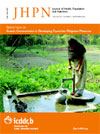
|
The Journal of Health, Population and Nutrition
icddr,b
ISSN: 1606-0997
EISSN: 1606-0997
Vol. 27, No. 3, 2009, pp. 396-405
|
 Bioline Code: hn09038
Bioline Code: hn09038
Full paper language: English
Document type: Research Article
Document available free of charge
|
|
|
The Journal of Health, Population and Nutrition, Vol. 27, No. 3, 2009, pp. 396-405
| en |
Perceptions of Quality of Care for Serious Illness at Different Levels of Facilities in a Rural Area of Bangladesh
Anwar, Iqbal
Abstract
This study was conducted to explore care-seeking for perceived serious morbidities and users’ perceptions about quality of care at different facilities in Matlab, Bangladesh. This is a secondary analysis of baseline
community survey data of the Matlab Essential Obstetric Care Project conducted in 2001. Principal component and factor analysis methods were used for computing summary quality and socioeconomic indicators. During perceived serious morbidity of any household member within the last one year, 88.1% (776/881) used health resource outside home. Of them, 25.6% visited informal care providers, 17.8% peripheral public facilities, 7.9% tertiary hospitals, 7.3% facilities of non-governmental organizations, and 41.4% private facilities as the highest healthcare resources. Socioeconomic status and type of morbidity were significant predictors for choice of the highest level of care. Most (86.1%) of those who sought care outside the home were satisfied with the quality of services provided for their last serious morbidities. Users of organized private-sector and tertiary facilities perceived the quality of services better than users of informal care providers and peripheral public facilities. Behaviour and attitude of the service providers and availability of medicines were significant predictors for perceived quality of care. Peripheral public-health facilities were of poor quality and grossly under-used. Further research should explore the technical aspect of quality of care in different facilities, along with perceptions of service providers to design client-focused interventions to impact the use of healthcare services. There is no reason to overlook informal care providers,
they should rather be trained and monitored.
Keywords
Healthcare; Healthcare-seeking behaviour; Health services; Patients’ satisfaction; Quality of care; Bangladesh
|
| |
© Copyright 2009 - International Centre For Diarrhoeal Disease Research, Bangladesh
Alternative site location: http://www.jhpn.net
|
|
